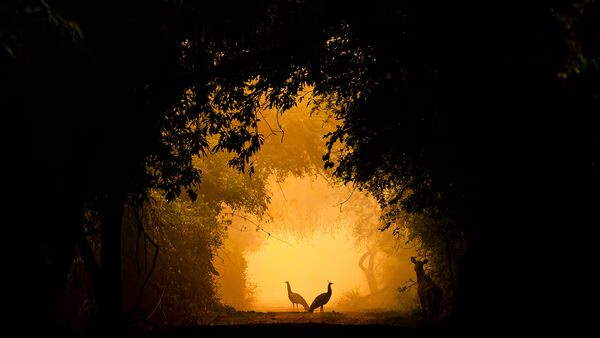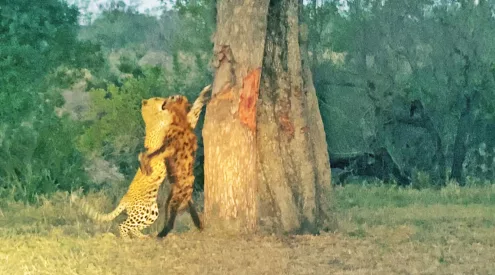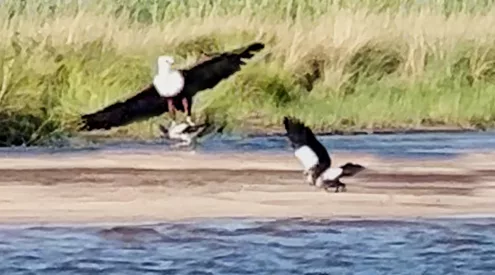Early in our travels in Africa, Mrs Blog and I coined a phrase to sum up a truly amazing wildlife sighting – a monumental experience. A monumental experience (ME) was something hitherto unexperienced, something that would be remembered forever, and which defined that year’s trip to Africa (we’ve visited Africa every year since 1995, from our native Australia).
In the beginning, the monumental experiences, given the benefit of hindsight, weren’t that monumental at all. The first time we parked up next to a pride of sleeping lions, just a couple of metres away from one of them, was an ME for that year, but since then we’ve been that close to lions countless times.
Other monumental experiences have stood the test of time. Still guaranteed to give a slight jolt of adrenalin are thoughts of the black rhino that chased our Land Rover for five kilometres in Hwange (it turned out it had been hand-reared and associated our Landy as the food truck); having lions circle our tent in Mana Pools; and watching a mother cheetah in Kruger National Park teach her two cubs the art of hunting with a live baby impala as the training aid.
These days it takes a lot though, for something to be classed as truly monumental, and I certainly didn’t expect to have one while sitting in a hole in the ground drinking beer.
To backtrack a little, we were in Zimbabwe, in Hwange National Park to be precise, taking a little well deserved R & R at a lovely private game lodge, The Hide, after having taken part in the annual Hwange Game Census this past October.
Mrs Blog and I have done the game count (as it’s better known) for the past 13 years and it’s always a treat to come back to this wonderful, but often maligned national park. Sure, Hwange, like all of Zimbabwe, has some serious problems, but don’t let that put you off visiting.
After a few years of very good rains Zimbabwe seems to be heading into drier conditions again, and the game in Hwange is beginning to take strain. Diesel pumps that supply the park’s man-made waterholes are breaking down and there’s never enough fuel for them in any case (and much of what is available in terms of diesel and repairs comes from a bunch of very dedicated individuals at the Hwange Water Project).
The lack of groundwater did mean that this year’s count was more productive, in terms of numbers of game seen, than recent years. During our count at the Little Toms hide, near Robins camp, we saw plenty of elephant, as well as zebra, impala, kudu, African wild cat, hyena, warthog and lions.
It’s sad to see the park’s elephant population suffering at the end of the dry season. The very old and very young sometimes don’t make it and as tragic as this is, mother nature tries her best to level things out. When the elephants suffer the lions and hyena do well.
Two lionesses passed close by our counting position in the middle of the night during the count and the next morning, as we packed up and left to return to camp, we found them again, not a hundred metres from where we’d spent the night. The lionesses, who turned out to have a cub with them, had killed a zebra in the small hours of the morning. We watched as a very protective, snarling lioness dragged the zebra carcass away from the road, and us, to the shade under a tree.
After the count we caught up with our friends from Australia, Brett and Claire, and meandered down through the park towards The Hide, stopping at Masuma Dam on the way. I almost hate writing this down for general consumption, but let me let you in on a little secret. Masuma picnic site is one of, if not the best, places to view game in southern Africa. Enough said.
The Hide is, literally, an oasis. While the bush around this concession that sits on National Railways of Zimbabwe-owned land jutting into Hwange is dry, yellow and chowed by elephants, The Hide’s permanent safari tents exist in a green tangle of vines and palms, overlooking their own pumped waterhole. The owners and staff at The Hide have the whole private game lodge experience nailed. Service is friendly and efficient without being overbearing and the tents, under their thick insulation of thatch, are cool and inviting. There’s a help-yourself honour bar and an inviting plunge pool.
One thing I don’t usually like in any hotel or lodge is communal dining – everyone around a big table. They do this at The Hide, but here’s the thing…their table is so huge that you actually can’t hold a conversation with everyone around it, or even the people opposite you, so you only end up talking to the people either side of you, which is quite nice. There’s a feeling of boisterous conviviality without having to engage in four simultaneous small-talk conversations. Each evening a nominated staff member welcomes new guests, by first name, to the dining table, and farewells those who are leaving the next day. It’s formal informality, and it works.
The Hide, still run by the family who established it, has weathered the recent hard years in Zimbabwe though there is still a way to go before the country’s tourism sector fully recovers. Trust me, this is a seriously good place in a seriously good national park and both deserve all the support they can get. There was game visiting the camp waterhole almost all of the time during the two days we stayed there; except, of course, when Brett and I decided to go and sit in the hide. The Hide (the camp) actually has two hides, as in viewing points. One is elevated on stilts and the other is underground. We took up the offer of experiencing life as an aardvark instead of going for an afternoon game drive.
Our armed guide, Daffy, walked us the hundred metres or so from the main part of the lodge to the underground hide, a man-made structure cunningly disguised as a termite mound. Daffy lifted a heavy iron trap door, checked inside for snakes, and Brett and I then climbed down a ladder.
We were left, armed only with a cooler box full of beer and water, feeling quite isolated. From inside, the hide was very much like a WWII bunker. Peering out the long narrow slit we pretended to machine gun Tom Hanks and his crew from Saving Private Ryan, and joked about what we’d do if a lion came up and reached in (there was actually a little trap door one could close).
It was a little close inside – room for three people, but good for two-plus cooler box – but we soon got used to this unusual vantage point. I’d never viewed game from absolute ground level, and it looked like I never would.
For the first couple of hours we saw nothing but birds. “What do you reckon the first mammal we’re going to see is?” Brett asked.
“The guy who comes to pick us up at 6.30pm,” I said.
We did, however, appreciate the birds and shot some very nice (if I do say so myself) pics of yellow billed kites, goshawks and egrets that all came to drink at the waterhole in front of us.
The beers were starting to take effect and I was about to line up a shot of a cape turtle dove (it was getting that desperate), when it happened.
The monumental experience.
Brett was pointing his camera across my front so he didn’t see the furry yellow and white face with the black teardrops under its eyes and suddenly appear at the slit, bared its fangs, and hissed at me.
“Brett!”
“What?” He was still checking the doves.
“Brett!” I couldn’t form the word.
“What?”
As I tried to bring my long lens up for a snap, banging it in the process, Brett finally looked where I was staring, mouth (mine) agape.
“Shit. It’s a bloody cheetah!”
I fired off a couple of frames and the cheetah backed off, spooked by the noise of our cameras, or perhaps our swearing, which just got bluer as we vented our shock and awe at what we’d just seen. The cat darted behind a bush and we thought we’d lost it when it came out again, in full view, to have another look at us from a bit of a distance.
It turned out to be a he – a big male. As we all recovered from our surprise meeting the cheetah strolled down to the waterhole and, eyes still on the jabbering creatures in the underground hide, proceeded to drink.
Just when we thought this sighting couldn’t get any more memorable a couple of elephant ambled up to the waterhole, caught sight and scent of the cheetah, and trumpeted. A young bull, doing a fine impression of a warthog, stuck his tail up in the air and chased the cheetah along the water’s edge and into the bush.
The cheetah had, as we learned later, been clearly visible from the lodge’s viewing deck for about half an hour as it sashayed up the vlei. Brett and I hadn’t been able to see our frantically waving wives, or all of the available camp staff and guides who had gathered to watch the two Aussie tourists be dug out of their burrow by a big cat. Mrs Blog said at one point she thought the cheetah was going to climb up on top of our fake ant hill!
As the sun began to slip behind the Hwange mopane stubble, herd after herd of elephants started arriving at the waterhole. At one point a matriarch came over to the underground hide and stuck the tip of her trunk in through the viewing slit to see what was inside.
If it hadn’t been for the cheetah, seeing the pink tips and nostrils of that trunk sniffing me from a hand’s breath away might have been qualified as a monumental experience.
Hwange National Park: (Zimbabwe)
Tel +27-12-803-7601, email [email protected], www.hwange.co.za
Mana Pools National Park: (Zimbabwe)
Tel +263-63-533/538 or visit the Zimparks Mana Pools website
The Hide (Hwange National Park):
Tel +263-4-498835/6, email [email protected], www.thehide.com
For rates and availability please visit The Hide website.


















